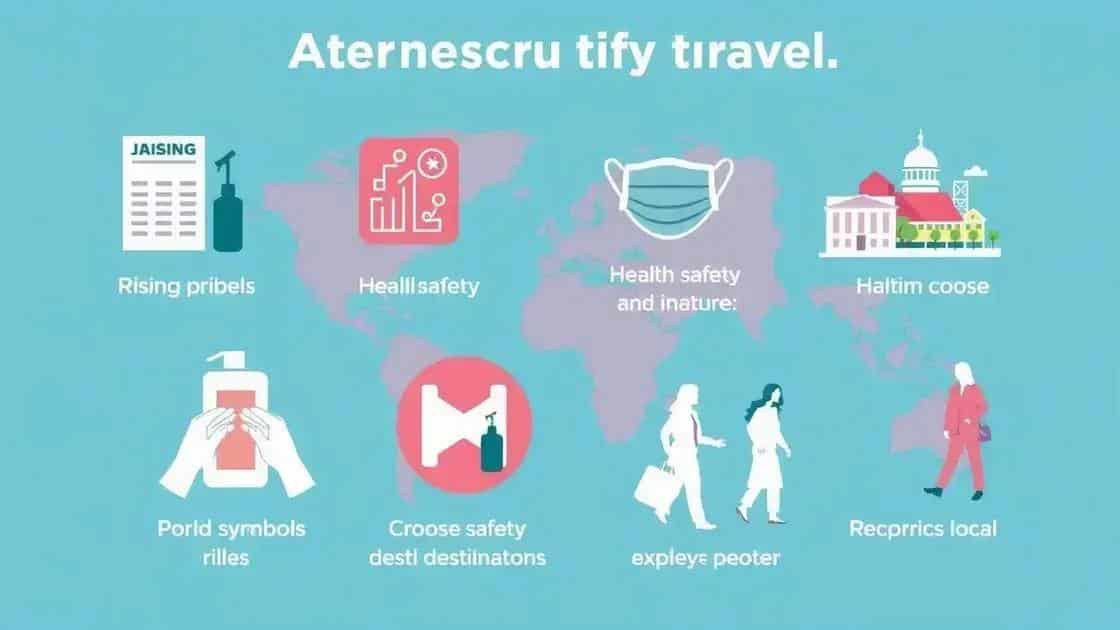Declining demand impacts U.S. international tourism

Declining demand impacts U.S. international tourism due to economic factors, health concerns, travel restrictions, and shifting consumer preferences, leading to significant effects on local economies and travel businesses.
Declining demand impacts U.S. international tourism, leaving many to wonder how this trend shapes travel experiences and the economy. What changes can we expect in the travel landscape? Let’s dive into the details.
Current trends in international tourism
The landscape of global travel is constantly changing. When we explore the current trends in international tourism, we notice several shifts that reflect the evolving preferences of travelers. Understanding these changes is crucial for stakeholders in the tourism industry.
Rising Popularity of Sustainable Travel
More travelers are prioritizing sustainability in their choices. This trend is reshaping how destinations market themselves. From eco-friendly accommodations to sustainable urban transport, the focus is on reducing environmental impact.
- Increased demand for eco-tours
- Preference for local and organic food sources
- Support for conservation efforts
Technology Integration
The incorporation of technology in travel planning and experiences is on the rise. Digital tools enhance convenience and accessibility for tourists around the globe. This includes the widespread use of mobile apps for bookings, virtual tours, and contactless services.
Moreover, social media greatly influences travel decisions, as people search for inspiration in experiences shared online. User-generated content influences perceptions and creates desire for diverse travel options.
Health and Safety Considerations
The COVID-19 pandemic transformed how people view health during travel. Now more than ever, travelers are conscious of safety measures and hygiene protocols. This has led to an increase in demand for transparent communication about health guidelines from travel companies.
Travelers are making decisions based on health and safety ratings. They prefer destinations that demonstrate a commitment to visitor safety, which can impact bookings significantly.
Personalization and Unique Experiences
Travelers today seek unique experiences tailored to their preferences. This trend emphasizes *personalization* over traditional packages. Tour operators that provide customizable itineraries are more appealing.
- Interest in off-the-beaten-path destinations
- Desire for authentic cultural interactions
- Growing demand for immersive experiences
As we look at these trends, it becomes clear that the future of international tourism is shaped by various factors that address the desires of modern travelers. By focusing on sustainability, technology, health, and personalization, the industry can adapt and thrive in this dynamic environment.
Factors contributing to declining demand

Understanding the factors contributing to declining demand in international tourism is key to addressing the challenges facing the industry today. Various elements are impacting travel choices, leading to fewer visitors to popular destinations.
Economic Factors
Economic difficulties greatly influence travel decisions. People often cut back on non-essential spending during tough economic times. When job security is uncertain, the first thing many consider is skipping trips or opting for local vacations.
- Increased cost of living affects disposable income
- Fluctuating gas prices influence road travel
- Currency exchange rates impact affordability for international travelers
Health Concerns
Ongoing health concerns, especially since the pandemic, have made travelers more cautious. They now prioritize destinations that clearly communicate health and safety measures. This shift in perspective leads people to reassess where and when they travel.
The fear of new variants or outbreaks can deter international trips, causing potential tourists to look for domestic alternatives instead. People are also inclined to avoid crowded places, which further limits their options.
Travel Restrictions
Government regulations and travel restrictions can have immediate effects on tourism. Changes in visa policies, quarantine requirements, and travel bans can discourage potential travelers. Many individuals prefer to avoid the stress of changing regulations, leading to reduced international travel.
Travelers are looking for predictability and ease of travel. Uncertainties about entry requirements or sudden lockdowns discourage bookings.
Changing Preferences
Recent trends show that preferences have shifted towards **local tourism** and experiences. Some travelers are choosing to explore their own countries rather than venture abroad. This shift may stem from the desire for comfort and familiarity during challenging times.
- Preference for road trips over air travel
- Increased interest in staycations and short getaways
- Desire for experiences closer to home
As we analyze these various factors, it becomes clear that addressing these challenges will require innovative solutions and a deep understanding of what travelers value in their experiences.
Impact on local economies and travel businesses
The impact on local economies and travel businesses due to declining international tourism is significant. As fewer travelers visit popular destinations, local businesses are feeling the strain.
Loss of Revenue
Local economies heavily dependent on tourism face immediate revenue drops. Restaurants, hotels, and shops see fewer customers. This decrease in demand can lead to job losses and business closures.
- Local restaurants report a decline in patrons.
- Hotels struggle to fill their rooms.
- Tourist attractions experience diminished foot traffic.
Changes in Employment
With fewer tourists, many travel-related jobs are at risk. Employment in sectors like hospitality, travel agencies, and entertainment declines. Workers may face reduced hours or layoffs, creating greater economic uncertainty.
The connection between tourism and local job markets means that communities might feel the effects for years to come. As businesses close or reduce staff, the overall economic health of the area suffers.
Shifts in Business Strategies
Businesses must adapt to the new reality of declining tourism. Some are pivoting to local markets by offering special promotions or creating services tailored to residents. Others explore alternative revenue sources, like virtual experiences or online sales.
- Local businesses offer discounts to attract nearby customers.
- Investing in online platforms to reach broader audiences.
- Creating community-focused events to engage locals.
Such adjustments can help sustain businesses and support the local economy. However, these shifts may not fully compensate for the absence of international tourists.
Challenges Ahead
The long-term effects of decreased tourism require careful consideration. Local economies may take time to recover, and businesses must continually adjust to changing visitor patterns.
As communities rebuild, collaboration between local governments and business owners will be essential. Focused efforts on promoting localized travel and attracting diverse visitors can help restore economic stability.
Future outlook for U.S. tourism industry

The future outlook for the U.S. tourism industry is shaped by various factors, including changing consumer preferences, economic conditions, and the ongoing recovery from recent global disruptions. Understanding these elements is essential for predicting how the industry will evolve.
Recovery Trends
As travel resumes, there is optimism about recovery in the tourism sector. Many people are eager to travel again, leading to increased bookings for both domestic and international trips. This renewed interest offers a positive outlook for the industry.
- Increased consumer confidence as health situations improve.
- Growing interest in leisure travel and outdoor activities.
- Investments in technology to enhance traveler experiences.
Shifts in Travel Preferences
The pandemic has altered how people view travel. Travelers are now seeking more immersive and meaningful experiences. The desire for personalized and unique trips continues to rise.
Travelers are also considering sustainable options that prioritize environmental responsibility. This trend signals a shift towards nuanced, intentional travel.
Government Initiatives
Government support can play a crucial role in the industry’s recovery. Programs designed to boost tourism, such as marketing campaigns and funding for infrastructure improvements, will be vital.
- Promoting domestic tourism through special events.
- Encouraging international visitors with streamlined travel processes.
- Building and enhancing attractions to draw visitors.
Emphasis on Health and Safety
The emphasis on health and safety will likely continue to influence travel decisions. Establishing clear protocols and ensuring visitors feel safe will remain a priority for the industry.
Businesses that adopt robust safety measures may enhance their reputations, thus attracting more travelers. Clear communication regarding health guidelines will also be essential.
Technological Innovations
Technological advancements will shape the future of tourism as well. Innovations in travel tech, such as virtual reality experiences and AI-driven customer service, are becoming more commonplace.
These technologies not only improve the traveler experience but also streamline operations for businesses. As travelers become more tech-savvy, companies must adapt to meet these expectations.
As we look ahead, the outlook for the U.S. tourism industry appears positive yet requires careful attention to emerging trends and challenges to ensure sustained growth.
In summary, the future of the U.S. tourism industry is influenced by various factors, including evolving consumer preferences, technological innovations, and the lasting effects of the pandemic. While challenges remain, there is a clear path to recovery for businesses willing to adapt. Focusing on sustainability, health and safety, and unique experiences will be vital. By embracing these changes, the industry can attract travelers and support local economies. Overall, with careful planning and a commitment to understanding what tourists value, the U.S. tourism sector can thrive in the years to come.
FAQ – Frequently Asked Questions about the U.S. Tourism Industry Outlook
What factors are currently influencing the U.S. tourism industry?
Key factors include changing consumer preferences, economic conditions, health and safety measures, and technological innovations.
How has health and safety affected travel decisions?
Health and safety concerns have led travelers to prioritize destinations with clear protocols and a commitment to visitor safety.
What role does technology play in the future of tourism?
Technology enhances traveler experiences through innovations like mobile apps, virtual reality tours, and AI-driven services, making travel more convenient.
How can businesses adapt to changing tourism trends?
Businesses can adapt by focusing on sustainable practices, offering personalized experiences, and improving online engagement to attract a diverse range of travelers.






